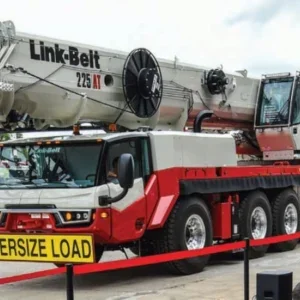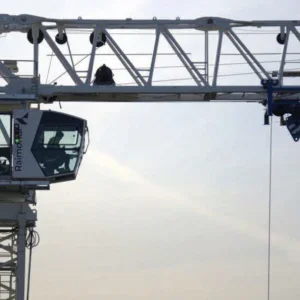According to the International Atomic Energy Agency there are roughly 442 nuclear power plants currently in operation around the globe.
With fairly steady increases to the total figure each year – currently another 65 are under construction – nuclear power still holds much promise for crane fleet operators poised for the right opportunity.
In the UK alone there are plans to build 10 or more nuclear power stations over the next 15 years to plug the energy gap that will be left by the decommissioning of several existing coal-fired reactors.
Among the long line of contractors tendering for work on these projects is British rental firm Weldex, who have enjoyed several opportunities provided by the power sector in recent years.
Having worked on four UK nuclear sites last year alone, Weldex are well aware of the equipment needed for the challenges involved.
Weldex sales and heavy crane manager, Simon Massey, explains: “Around 30% of all our hires come from the power sector. What’s been particularly good for us over the last few years is gas-fired nuclear power station work.
“You do have a full spectrum of cranes on these jobs from 40t to over 1000t. What you need for a lot of these jobs are very compact cranes, for better manoeuvrability on site, with high capacities and a long working radius.”
The Weldex fleet comprises of mainly Liebherr cranes, but they do not shy away from purchasing cranes from other manufacturers if it can give them a competitive advantage.
Speaking to Cranes Today, Weldex managing director Dougie McGilvray said: “We have bought a Kobelco CKE1800, and that crane will go into Sellafield for a 12 month contract. That was bought for the specific duties it can do that no other crane could do.”
The firm is also working on the site of Pembroke’s new combined cycle gas turbine (CCGT) power station.
The £1bn facility, which will generate 2,000MW of electricity each year, required a range of cranes to get the job done.
“At Pembroke power station we have various cranes, including five small cranes ranging between 40t and 100t,” says Massey. “These machines are for installing pipework, access equipment, walkways and structural steel. On a power station of that kind of size you are probably talking about 20 to 25 cranes, which is usually a mixture of crawler cranes and mobile cranes.
“At the moment we are heavily involved in tendering for nuclear to the extent that we’re looking to add to our fleet for these projects, and enhance the capacity of our crane fleet beyond current capacity.”
The largest cranes currently in the Weldex fleet are two 1,350t Liebherr LR11350s, so any new acquisitions above this level will have a significant cost implication, further demonstrating the firm’s expectations of this sector.
Although important, the nuclear sector only represents one portion of the company’s focus on power.
Massey says the majority of Weldex’s current workload comes from the renewables sector, often from overseas clients performing offshore wind farm installations.
On one job Weldex provided onshore crane support with capacities of up to 1,000t to lift the large monopiles that can easily weigh 600t to 700t.
Like many companies, Weldex’s client base seems to be predominantly from OECD countries – although Massey states the firm will support any of its customers worldwide – but as the world power generation market continues to grow, companies may soon concentrate their efforts further afield.
In 2003, the International Energy Agency (IEA) released the World Energy Investment Outlook report forecasting that global primary energy demand would grow, on average, by 1.7% each year.
Although this figure hasn’t fluctuated much, by the time the IEA’s 2010 report was published IEA analysts had come to an important conclusion regarding countries outside of the OECD.
While total energy demand in OECD member states could be expected to average around 14%, for non-OECD countries an 84% increase is expected by 2035, with the China and India accounting for 30% of global energy consumption.
China has already taken over from the USA as the world’s leading producer of wind power as of mid-2010, and single-handedly boosted the wind energy market by accounting for nearly 35% of the increase in global wind power capacity in 2009.
India’s massive infrastructure investment plans for the next few years coupled with a raft of tenders currently available for power projects confirms Asia’s importance on the world energy stage.
A recently released report by Market research consultancy Markets and Markets supports this claim, showing that Asia is expected to outpace Europe for wind turbine installation rate by 2013 and become the fastest growing region for a market pegged to be worth $73.5bn by 2015.
With most countries signed up to increase the proportion of domestic energy they generate from renewable sources to around 15% or 20%, more work from the fledgling sector can be expected.
Even in Britain, Scotland has hit it’s interim target to produce 31% renewable energy by 2011, and is targeting 80% by 2020. Ainscough Crane Hire have recently completed the installation of nearly half of the 3MW Vestas V90 wind turbines installed at the Arecleoch Wind farm in Ayrshire, which provides a significant portion of Scottish renewable power.
Using two 500t cranes (a Liebherr LG 1550 and a Liebherr LTM 1500 8.1) over 30 turbines were installed before Ainscough moved onto another wind energy job in Ayrshire just a few miles away.
Compared to other renewable considered minor markets by most, such as biomass reactors, solar energy, and to a certain extent hydroelectric, wind is gaining momentum rapidly. At the end of 2009 the World Wind Energy Association estimated that 159.213MW of wind energy was being generated globally. Market researchers Global Industry Analysts believe this figure will mushroom over two years to provide 707,570MW of wind energy worldwide by 2012.
With many analysts expecting wind turbine prices to fall below 2009 prices over the next five years, this can only expedite the already rapid global expansion in wind power.
This imminent exponential growth, in conjunction with the maintenance and upgrading of existing installations, should guarantee crane fleet owners a wealth of opportunity for a promising 2011.






